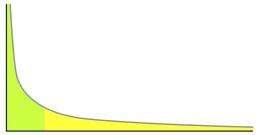February 10, 2012 report
A frank discussion of the power law and linking correlation to causation

(PhysOrg.com) -- Michael Stumpf a mathematics professor at Imperial College in London, and Mason Porter a lecturer at Oxford have teamed together to write and publish a perspective piece in Science regarding the inexact science of trying to apply the power law to situations in science where it’s not always easy to show a direct link between correlation and causation, a key problem they say, in much of the science that is conducted today.
A power law is where a relationship between two quantities exists that can be described mathematically where one measurement is directly related to the outcome of another. In their perspective the authors describe it as related via an exponent which can be mathematically described. One example is where the surface area of a sphere is firmly fixed to its radius, i.e. the area increases proportionally as the radius does. In such cases, its scalable, it doesn’t matter how large or small the sphere is, its surface area can still be calculated using the same formulaic relationship. It’s also meaningful, i.e. the relationship formula can be used to actually calculate sphere surface areas.
In their perspective, the authors use the relationship between the metabolic performance of an organism and its body size, which biologists describe using allometric scaling, a power law, to make their assertions. Research has shown that using such a formula allows scientists to calculate the second when obtaining the first through measurement, regardless of body size, a clear and useful thing when studying virtually any organism.
In their perspective, however, the authors point out that not all areas of science are so compliant, which leads to all manner of assumptions regarding outcomes that may or may not be true. One prime example is when researchers collect data points and find they can draw a line though them, which suggests a correlation. Unfortunately, quite often other lines could have just as easily been drawn, indicating there was no correlation at all. The point here is that in scenarios where the power law cannot be applied, researchers are often left to make educated guesses, going on little more than intuitive leaps based on past experience. This is especially important when it is a practicable impossibility to obtain a reasonably large sample size.
They also point out that many instances occur in research where the power law is applied in ways that don’t actually make sense. For example, if a line is drawn though a set of data points showing correlation, it won’t matter much if that line doesn’t offer any real insight into what is being demonstrated.
Because of such scenarios, the authors conclude that it might behoove the scientific community, both researchers and readers of scientific papers alike, to apply some bit of skepticism to such claims when they are made.
More information: Critical Truths About Power Laws, Science 10 February 2012: Vol. 335 no. 6069 pp. 665-666. DOI: 10.1126/science.1216142
The ability to summarize observations using explanatory and predictive theories is the greatest strength of modern science. A theoretical framework is perceived as particularly successful if it can explain very disparate facts. The observation that some apparently complex phenomena can exhibit startling similarities to dynamics generated with simple mathematical models (1) has led to empirical searches for fundamental laws by inspecting data for qualitative agreement with the behavior of such models. A striking feature that has attracted considerable attention is the apparent ubiquity of power-law relationships in empirical data. However, although power laws have been reported in areas ranging from finance and molecular biology to geophysics and the Internet, the data are typically insufficient and the mechanistic insights are almost always too limited for the identification of power-law behavior to be scientifically useful (see the figure). Indeed, even most statistically “successful” calculations of power laws offer little more than anecdotal value.
Journal information: Science
© 2011 PhysOrg.com





















